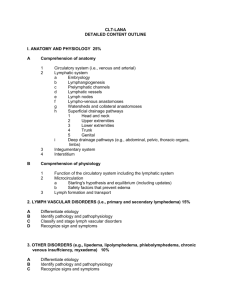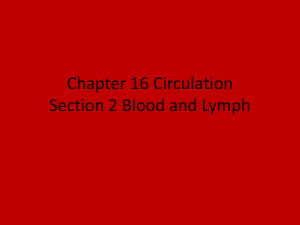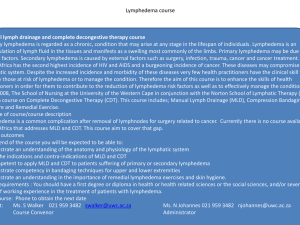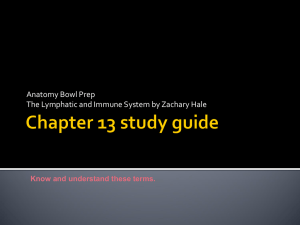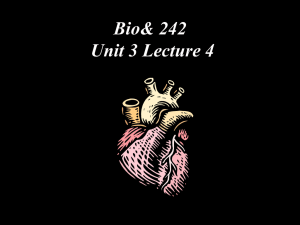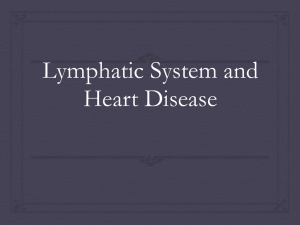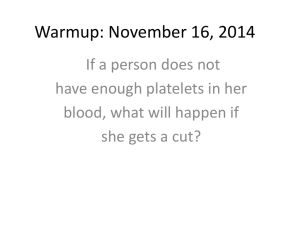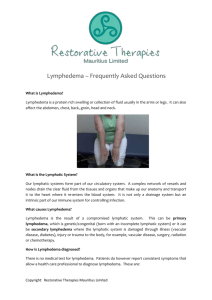6.10.13 Intervention for Lymphedema
advertisement
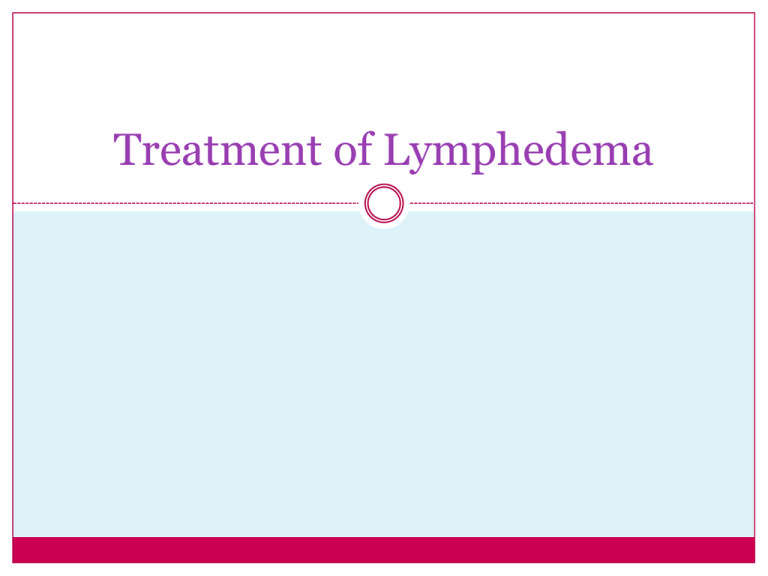
Treatment of Lymphedema Lymph Anatomy Lymph nodes Lymph vessels Thymus gland Spleen Tonsils Peyer’s patches Lymph Vessels Capillaries Pre-collectors Collectors Trunks Lymph Capillaries Larger diameter than blood capillaries No valves Lymph can flow in any direction Can absorb interstitial fluid Pre-Collectors & Collectors Pre-Collectors Channel lymph fluid into transporting vessels Can absorb fluid Collectors Transporters Resemble veins in structure Passive valves: ever .6-2cm along vessel Lymphangioactivity Contractions caused by Sympathetic Nervous System and lymph volume Superficial and deep Trunks & Ducts Largest lymph vessels Thoracic duct-largest, pumping by the diaphram. From in cisterna chyle Ducts empty into venous system Lower Body Upper Body •R & L Lumbar Trunks •Intestinal Trunks •R & L Jugular •R & L Subclavian •R & L Broncho-mediastinal Lymph Fluid/Lymphatic Load Consists of: Proteins (1/2 of bodies protien) Water Cells (RBC, WBC, Lymphocytes) Waste Products Fat (intestinal lymph, chyle) Lymph Nodes Filtering station for bacteria, toxins, & dead cells Produces lymphocytes Regulates the concentration of protein in the lymph Typically thickens the fluid 600-700 in body Lymphatic Watersheds Median-Sagittal Tranverse Clavical Spine of Scapula Chaps or Gluteal Lymph Time Volume & Transport Capacity LTV= amount of lymph which is transported by the lymphatic system in a unit of time TC=maximum lymph time volume Functional Reserve=the difference between the LTV and the TC Defining Types of Lymphatic Insufficiencies High Volume or Dynamic Insufficiency High Output Failure Leads to Edema TC Low Volume or Mechanical Insufficiency Low Output Failure= Lymphedema TC LL=LTV LL LTV Lymph Propulsion Arterial pulsation Muscle pump Respiration Contraction of the lymphangion Definition of Lymphedema Lymphedema is the result of the abnormal accumulation of protein rich edema fluid Primary or secondary Afflicts approximately 1% of the US population (2.5 million people) * A SUDDEN ONSET OF EDEMA MUST BE THOROUGHLY EVALUATED BY A PHYSICIAN Physical Exam History Inspection Measurements: weight, circumference Skin assessment: nodules, bumps, discoleration Palpation Temperature: usually a bit warmer Stemmer’s sign: rolls on finger, square and thick skin Skin fold(s) Pitting Fibrosis Other Diagnostic Tests Lymphography Venous Doppler or Venous Sonography Indirect Lymphography Fluorescence Microlymphography Lymphoscintigraphy CT Scan MRI Types of Lymphedema Primary Hypoplasia (not as many lymph nodes) Hyperplasia Aplasia Inguinal Node Fibrosis (Kineley Syndrome Secondary Surgery Radiation Therapy Trauma: blunt trauma Filariasis: parasite, blocks Milroy’s Disease-congentital, males, unilateral typically Meige’s Syndrome: most females around puberty, Bilateral, webbing of fingers and toes, two rows of lashes lymph nodes Cancer (Malignant) Infection Obesity Self Induced Stages of Lymphedema Latency Stage Reduced transport capacity No noticeable edema Stage I Pitting edema Edema reduces with elevation (no fibrosis) Tight sleeve during the day Stage II Pitting becomes progressively more difficult Connective tissue proliferation (fibrosis) Stage III Non pitting Fibrosis and Sclerosis Skin changes (papillomas, hyperkeratosis, etc) Differential Diagnosis Lipidema: females, symmetrical (no feet), no pitting, very painful to palpations, bruise easily, tissue is softer. Chronic Venous Insufficiency: gaiter distribution, non-pitting, hemosiderin staining, fibrotic. Acute Deep Venous Thrombophlebitis: swelling, redness, painful, sudden onset Cardiac Edema: bilateral, pitting, complete resolution when legs elevate above heart, no pain. Congestive Heart Failure: pitting, dyspnea, jugular vein distention. Malignancy: Filariasis: Myxedema: decreased ability to sweat, orange skin Complex Regional Pain Syndrome (RSD, Sudeck’s) Chronic Venous Insufficiency Filariasis Lymphedema Interventions Surgery (Debulking, Liposuction) Taking out all the lymphatic with these surgeries Medication (Diuretics, Benzopyrones) Takes out all the water, but leaves lymphatic's with protein rich lymph fluid. Pneumatic Compression Pump May harden the tissue or destroy lymph collectors, and leave person immobile for a couple of hours. COMPLETE DECONGESTIVE THERAPY Removes proteins from the system. Anti-Edema Medications Not effective because: Do not allow the proteins to be reabsorbed into the venous system As long as proteins are stagnate in the interstitial space the onconic pressure remains high and lymphedema persists Can worsen Lymphedema in the long run as they increase the concentration of proteins in the interstitial space exacerbating fibrosis Treatment Schools of Thought Casley-Smith Foldi LeDuc Vodder Norton Klose Complete Decongestive Therapy (CDT) Skin Care Manual Lymph Drainage Compression Therapy Remedial exercise Purpose of lymphatic treatment Applied pressure softens fibrotic tissue Excess protein is removed Formation of new tissue channels through anastomoses Provide support Enhance oxygenation by decongesting areas where lymph volume is high Long-term maintenance of improved limb size and shape Contraindications (precautions) to CDT Acute bacterial or viral infection Wait 24 hours of antibiotic treatment before resuming treatment. Acute CHF h/o CHF treat conservative, 1 limb at a time Kidney malfunction Untreated malignancy The existence of impaired arterial perfusion for compression ABI < 0.50 Precaution/ Rationale Contraindicatio n Modification DVT Do not treat in the area of an acute DVT. Fear is dislodging causing a life threatening emboli Treat adjacent areas Await medical clearance prior to treating affected area Active Infection Do not treat with an active infection. Fear of spreading infection Wait until appropriate antibiotic therapy has been initiated and show signs of resolving Open wound Do not treat areas with breaks in the skin Treat adjacent areas of intact skin Metastatic Disease Fear of spreading cancer Palliative care; Team decision Congestive Heart Failure Fear of systemic fluid overload Must be controlled, then treat conservatively and monitor Asthma Fear that parasympathetic stimulation will provoke an asthma attack Must be controlled, then treat conservatively and monitor AAA, Diverticulitis, IBS, Crohn’s disease Deep abdominal techniques may aggravate or worsen these conditions Do not perform deep abdominal techniques Pregnancy Fear deep abdominal techniques may harm the fetus or uterus Do not perform deep abdominal techniques Patient education Protect the skin Signs of infection Gradual return to activity Self management Self massage Compression garments Exercises Weight Management Obesity and body fluid volume fluctuations are beginning to be associated with the development of lymphedema Protect the skin : Individuals that have had lymph nodes removed are at risk for lymphedema. To minimize this risk the following precautions should be followed: Keep arm clean and dry. Apply moisturizer daily to prevent chapping/chaffing of the skin. Balance lotion Attention to nail care; do not cut cuticles. Protected exposed skin with sunscreen and insect repellent. Use care with razors to avoid nicks and skin irritation. Avoid punctures such as injections and blood draws. Wear gloves while doing activities that may cause skin injury If scratches/punctures to skin occur, keep clean and observe for signs of infection. Gradually build up the duration and intensity of any activity or exercise, and monitor arm during and after for any change in size, shape, firmness or heaviness. Avoid arm constriction from blood pressure cuffs, jewelry and clothing Avoid prolonged (>15 minutes) exposure to heat, particularly hot tubs and saunas Airplane flights: due to decrease pressure in cabin, will need a compression sleeve Signs of infection Red Hot Pain Swelling Fever Generalized Fatigue Exercises Effect of movement on lymphatics - lymph flow; abdominal breathing Development of an effective exercise program 1.) flexibility exercises 2.) strengthening exercises 3.) aerobic exercises 4.) response of limb is important Lymphatic Drainage Exercises Move fluids through lymphatic channels Active repetitive ROM exercises are performed Follow a specific sequence to move lymph away from a congested area Proximal to distal Avoid static dependent postures Lymphatic Drainage Exercises 20 – 30 minutes each session Twice daily 7 days a week Wear compression bandages or garment during exercises Combine with deep breathing Rest if possible for 30 minutes following exercises Check for redness or increased swelling Sequence of exercises Proximal starting at neck and trunk Proximal joints moving distally 5 reps – 20 reps Manual Lymph Drainage (MLD) a manual technique to mobilize fluid in the lymph system, by movement of proteins and fluid into the initial lymphatic vessels. This manual technique is done lightly and slowly. Manual Lymph Drainage (MLD) Basic Principles: 1. Proximal area is treated first, clearing first the adjacent and unaffected lymphotomes, then proximal sections of the affected lymphotomes. 2. The direction of pressure depends on the areas of edema and the direction should always be towards a cleared lymphotome. 3. Technique and variations are repeated rhythmically. 4. Pressure phase lasts longer than relaxation phase. 5. As a rule there should be no reddening of the skin Manual Lymph Drainage (MLD) Techniques: 1. Call-up - proximal to edema To clear the collectors proximal to the area Using the Thumb side of hand 2. Reabsorbtion - edematous region Using the 5th digit side of hand Increases protein reabsorption Manual Lymph Drainage (MLD) 1. Mobilize the skin 2. Apply Pressure 3. Relax Technique is done lightly and slowly MLD – Upper extremity 1: Supraclavicular nodes 2: Axillary nodes 3: Inguinal nodes 4: Thigh 5: Popliteal fossa 6: Calf 7: Malleolli 8: Dorsum of foot 9: Toes Upper Extremity mld MLD – Upper extremity 1: Supraclavicular nodes 2: Axillary nodes 3: Anterior chest 4: Back 5: Mascagni Pathway 6: Upper arm 7: Cubital nodes medial/lateral elbow 8: Forearm supination / pronation 9: Dorsum/palm of hand 10: Fingers Lower Extremity mld Protocol Duration 2 weeks UE 3 – 4 Weeks LE Frequency 5 days a week Arm 30 - 45 minutes Leg 45 - 60 minutes Wear Bandages During all awake hours Week 1 Emphasis on Bandages and reduction of Swelling Week 2-3 Facilitate Physician order for Garment Self Management of Edema Abdomina l Nodes Treatment Of Abdomen - Deep Position patient so that hips and knees are flexed Patient performs slow diaphragmatic breathing On exhale apply slow, gentle but firm pressure on area Pressure is toward the cistera chyli On inhale give gentle resistance to promote increased expansion and provide proprioception If you can palpate the aorta do not apply pressure Treatment Of Abdomen - Deep Contraindications Pregnancy Endometriosis Hiatal hernia Compression bandages Compression bandages Compression bandages have been shown to produce a micromassage effect that improves lymph transport. Increase temperature of up to 5 degrees enhances the lymphangion mobility Bandages Resting pressure - Pressure from the outside in the resting position of the muscle. Pressure applied from fascia, bandages Working pressure - Pressure from the inside when the muscles are active. Pressure generated by the muscles Resting Pressure BANDAGE LYMPHATICS MUSCLE Working Pressure BANDAGE LYMPHATICS MUSCLE Types of compression bandages Elastic high stretch bandage - high resting pressure and low working pressure Not effective for treating lymphedema High resting pressure does not allow the lymphatics to fill And low working pressure does not increase tissue pressure effectively enough to influence the lymphatic pump because it stretches when the muscle contracts Types of Compression bandages Low stretch bandage - low resting pressure and high working pressure low resting pressure allows the lymphatic to fill High working pressure compresses the lymphatic vessels between the muscle the bandage facilitating lymphatic flow Low Stretch Compression Bandages Form a semi rigid support which causes an increase in interstitial pressure when the muscle contracts When a patient wears low stretch compression bandages while sleeping or resting the increased interstitial pressure will reduce the amount of fluid and protein leaving the arteriole (ultra filtration) and less edema is formed When a patient wears low stretch compression bandages during activity the increased interstitial pressure not only reduces ultra filtration but increases reabsorbtion into the lymphatic system which decreases lymphedema and well as venous edema Principles of Bandaging Must use Low stretch Always start distally and proceed proximally Maintain moderate tension Avoid creases and folds Use tape to secure…not clips or pins Applied with greater pressure distally than proximally Do not extend bandage to maximal length Principles of Bandaging – con’t Check pressure gradient Place more layers for increase compression rather than applying them more tightly Fill indentations with padding or foam pieces Cover as much of the limb as possible Compression to be worn until next visit Exercise with bandages on to take advantage of muscle pump effect Bandaging Supplies Scissors Tape Lotion – low pH Tubular bandage Protects the skin, skin hygiene, absorbs perspiration Elastic gauze/finger/toe wraps/Coban Padding – Artiflex or foam Prevents indentations in skin, equalizes pressure, protects tender areas Low stretch compression bandages 6 cm: foot, hand 8 cm: ankle, forearm 10 cm: lower leg, upper arm 12 cm: upper thigh When to instruct the patient to remove the bandages If the patient gets short of breath or has heart palpations If the fingers/toes are numb, blue or tingling If the wraps fall off If the patient is experiencing too much pain Compression Therapy Compression therapy is the application of external pressure on body tissue to support the elasticity of the skin and its underlying vessels Phase I with Compression Bandages Phase II with medical compression Garments Rationale for using compression therapy: Compression therapy directly effects the underlying lymphatic vessels, veins and tissue. Improves the efficacy of the muscle pump by creating a semi-rigid support for the muscle to work against Causes a mild increase in total tissue pressure Improves and maintains the shape of the limb Compression Garments Not designed to decrease edema- only to maintain the edema reduced by the treatments Increases reabsorbtion Increases tissue pressure ready made vs. custom ill fitting garment is worse than not wearing one at all MedaFit garments Donning Compression Garment For LE : put on in bed Use gloves to don and doff Apply on an “empty” limb Garment Compression Classes Over the counter -- 10-18 mmHg CC1 ----------------- 20-30 mmHg CC2 ----------------- 30-40 mmHg CC3 ---------------- 40-60 mmHg CC4 ---------------- 60+ mmHg Sequential Pneumatic Devices Mobilizes interstitial fluid into the venous system Single chamber - JOBST vs. sequential Compression (gradient) Use MLD prior to using the pump Studies show that it moves only venous fluid Pump never to exceed 40 mmHg for extended periods of time Sequential Pneumatic Devices Lympha Press Pressure range is 20-180 mmHg. Pressure is distributed into overlapping air compartments which are contained in a special sleeve. The compartments are sequentially inflated, from distal to proximal, massaging the limb in a proximal direction. The overlapping compartments prevent any gaps in treatment, to achieve a maximal and safe reduction of the lymphedema. The treatment cycle starts by filling the distal compartment first and continues inflating the remaining compartments in sequence during the first 24 seconds until all are full. The pressure is held in all compartments for 2 seconds, then deflates for four seconds which completes the 30 seconds cycle. The cycle then repeats itself. LASER Another new frontier in the treatment of lymphedema involves using the laser. From various trials lasers appear to help lymph flow, shown to be effective improvement of wound healing, and it has been used effectively in treating edema from DVT’s. The FDA has approved a laser device to be used in the treatment of post-mastectomy arm lymphedema. Clinical trials are currently underway for leg lymphedema. Lymphedema and its complications can causing "scarring" of the lymphatic system. The laser is useful in removing the scar tissue, thereby helping lymph flow. Energy Density - Suggestions Type of Condition Suggested Treatment Dose Range (J/cm2) Soft Tissue Healing 5-16 Fracture Healing 5-16 Arthritis – Acute 2-4 Arthritis - Chronic 4-8 Lymphedema 1.5 Neuropathy 10-12 Acute Soft Tissue inflammation 2-8 Chronic Soft Tissue Inflammation 10-20 The Short-term Effects Of Low-level Laser Therapy In The Management Of Breast-cancer-related Lymphedema Dirican et al; Supportive Care in Cancer; June 2011 17 BCRL patients referred to program between 2007 and 2009 All patients previously experienced at least one conventional treatment modality Complex physical therapy Manual lymphatic drainage Pneumatic pump therapy LLLT was added to patients’ ongoing therapeutic regimen All patients completed full course of LLLT Two cycles Results Difference between sums of the circumferences of both affected and unaffected arms Decreased 54% after first cycle Decreased 73% after second cycle Pain score 14 out of 17 experienced decreased pain with motion by an average of 40% after first cycle and 62.7% after second cycle Scar mobility Increased in 13 patients Range of motion Improved in 14 patients
